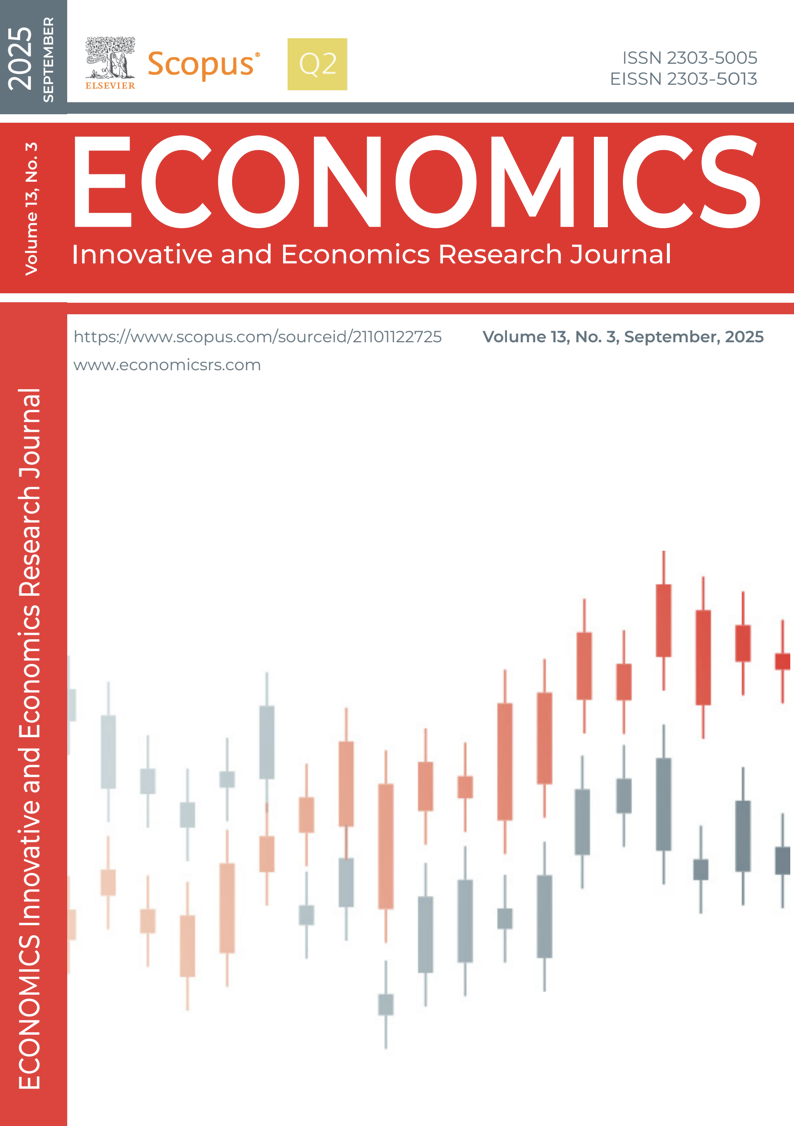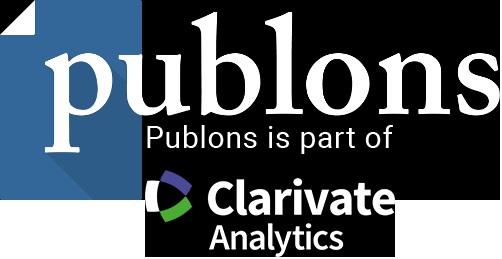DIVERSIFICATION OF BUSINESS THROUGH DIGITAL TECHNOLOGIES: CASE STUDY OF KAZAKHSTAN INDUSTRIAL COMPANIES
DOI:
https://doi.org/10.2478/eoik-2025-0073Keywords:
Diversification, Digital technologies, business performance, multiple regression analysis, industrial firmsAbstract
This article examines the impact of digital technologies on the diversifi-
cation of industrial enterprises’ activities, using the example of industri-
al firms in Kazakhstan. A literature review was conducted to analyze the
influence of digital technologies on financial, human resource, and lo-
gistics indicators of enterprises, as well as their effects on activity diver-
sification. Based on the review and expert interviews, the authors devel-
oped survey questions and conducted a survey among 230 respondents
who are middle and high-level managers of industrial enterprises in
Kazakhstan. Using the Smart PLS program, we employed a dual-model
approach: one to measure variables like digital technologies, financial
performance, HR performance, logistic performance and diversification
levels (Formative model), and another to analyze their relationships
(Structural Equation Modeling, SEM). The findings indicate strong con-
vergent validity among the variables studied. Interestingly, digital tech-
nologies have a significant impact on financial and HR performances,
but less so on logistic performance. This highlights a common issue
among most industrial enterprises: the limited use of digital technolo-
gies in their logistical consolidation. Moreover, while financial and HR
performances strongly influence enterprise diversification, logistic has a
minor effect. These results underscore the intricate dynamics within en-
terprise management frameworks and highlight how technological and
organizational strategies can affect diversification outcomes differently.
The results of the study can be useful for supporting the theory of the
relationship between digital technologies and the diversification of en-
terprise activities, as well as for identifying problem areas that require
deeper analysis and intervention by top managers of enterprises.
References
Alawneh, O. M., Tawalbeh, J., & AlOqaily, A. N. (2025). Reveling the interrelationship of digital transforma-
tion and business intelligence techniques to boost human capital development. ECONOMICS - Inno-
vative and Economics Research Journal, 13(1), 509–524. https://doi.org/10.2478/eoik-2025-0024
Arunsankar, N. (2021). Assessing the performance of logistics with the special reference to SNP Transport
Ltd with specific indicators. YMER Digital, 20(10), 21–31. https://doi.org/10.37896/YMER20.10/3
Babelova, Z. G., Vraňakova, N., & Stareček, A. (2023). The integration of HR information systems
utilization in industrial enterprises. MM Science Journal, 2023(5), 7027–7034. https://doi.
org/10.17973/MMSJ.2023_12_2023092
Baimukhanbetova, E. E., Tazhiyev, R. O., Sandykbayeva, U. D., & Jussibaliyeva, A. K. (2023). Digital tech-
nologies in the transport and logistics industry: Barriers and implementation problems. Eurasian
Journal of Economic and Business Studies, 67(1), 82–96. https://doi.org/10.47703/ejebs.v1i67.255
Bolyssov, T., Yessengeldin, B., Akybayeva, G., Zhanseitov, A., & Sultanova, Z. (2019). Features of the
use of renewable energy sources in agriculture. International Journal of Energy Economics and
Policy, 9(4), 363–368. https://doi.org/10.32479/ijeep.7443
Carter, C. R., & Rogers, D. S. (2008). A framework of sustainable supply chain management: Moving
toward new theory. International Journal of Physical Distribution & Logistics Management,
(5), 360–387. https://doi.org/10.1108/09600030810882816
Cerrato, D., La Rocca, M., & Alessandri, T. M. (2022). When does unrelated diversification increase
performance? The effects of financial context and contingencies. Management Decision, 61(13),
–25. https://doi.org/10.1108/MD-02-2022-0225
Dalenogare, L. S., Benitez, G. B., Ayala, N. F., & Frank, A. G. (2018). The expected contribution of
Industry 4.0 technologies for industrial performance. International Journal of Production Eco-
nomics, 204, 383–394. https://doi.org/10.1016/j.ijpe.2018.08.019
Geringer, J. M., & Hébert, L. (1991). Measuring performance of international joint ventures. Journal of
International Business Studies, 22(2), 249–263. https://doi.org/10.1057/palgrave.jibs.8490302
Globalink Logistics. (2025, January 16). Globalink’s ESG drive: Reducing paper use and leading sustain-
ability through digitization [Company news release]. https://globalinklogistics.com/bez-rubri-
ki-en/globalink-s-esg-drive-reducing-paper-use-and-leading-sustainability-through-digitization/
Government of the Republic of Kazakhstan. (2017, December 12). Decree No. 827 on approval of
the State Programme “Digital Kazakhstan” (2018–2022). https://cis-legislation.com/document.
fwx?rgn=102961
Government of the Republic of Kazakhstan. (2022, May 17). Government Decree No. 311 on approv-
al of the National Project “Digital Era Lifestyle” (DigitEL). https://adilet.zan.kz/rus/docs/
P2200000311
Guo, X., Li, M., Wang, Y., & Mardani, A. (2023). Does digital transformation improve firm perfor-
mance? From the perspective of the digitalization paradox and managerial myopia. Journal of
Business Research, 163, Article 113868. https://doi.org/10.1016/j.jbusres.2023.113868
Guzmán, G. M., Serna, M. de C. M., de Lema, D. G. P., Enríquez, L. A., & Adame, M. G. (2010). La
influencia de las TIC en el rendimiento de la PyME de Aguascalientes. Investigación y Ciencia,
(47), 57–65. https://www.redalyc.org/pdf/674/67413393008.pdf
Hair, J. F., Ringle, C. M., & Sarstedt, M. (2011). PLS-SEM: Indeed, a silver bullet. Journal of Marketing
Theory and Practice, 19(2), 139–152. https://doi.org/10.2753/MTP1069-6679190202
Hair, J. F., Hult, G. T. M., Ringle, C. M., & Sarstedt, M. (2022). A primer on partial least squares struc-
tural equation modeling (PLS-SEM) (3rd ed.). SAGE Publications. https://doi.org/10.1007/978-
-030-80519-7
He, J., Fan, M., & Fan, Y. (2024). Digital transformation and supply chain efficiency improvement: An
empirical study from A‐share listed companies in China. Plos One, 19(4), Article e0302133.
https://doi.org/10.1371/journal.pone.0302133
Diversification of business through digital technologies: Case study of Kazakhstan industrial companies
He, N., Wu, W., & Liu, S. (2021). Relationship between logistics firm size and business diversification:
An empirical study of Chongqing, China. Open Journal of Statistics, 11(1), 1–18. https://doi.
org/10.4236/ojs.2021.111001
Kock, N., & Hadaya, P. (2018). Minimum sample size estimation in PLS-SEM: The inverse square
root and gamma-exponential methods. Information Systems Journal, 28(1), 227–261. https://
doi.org/10.1111/isj.12131
Kupalova, H., Honcharenko, N., Andrusiv, U., Jakupova, D., Oleshko, E., & Demchenko, K. (2024).
Organizational and financial aspects of distribution management of digital content. Financial
and Credit Activity: Problems of Theory and Practice, 5(58), 500–511. https://doi.org/10.55643/
fcaptp.5.58.2024.4502
Mamrayeva, D. G., Babkin, A. V., Tashenova, L. V., & Kulzhambekova, B. Sh. (2022). Key aspects of
digital transformation of logistics companies in Kazakhstan. Bulletin of the Karaganda Univer-
sity: Economy Series, 107(3), 95–102. https://doi.org/10.31489/2022Ec3/95-102
Meena G, & Santhanalakshmi, K. (2025). Deconstructing Digital Transformation: A Multidimensional
Analysis of Digital Literacy’s Role in Shaping Human Capital and Driving Organizational Suc-
cess. ECONOMICS - Innovative and Economics Research Journal, 13(1), 405–430. https://doi.
org/10.2478/eoik-2025-0018
Miles, J. N. V. (2005). Tolerance and variance inflation factor. In B. S. Everitt & D. C. How-
ell (Eds.), Encyclopedia of statistics in behavioral science. John Wiley & Sons. https://doi.
org/10.1002/9781118445112.stat06593
Mvubu, M., & Naude, M. J. (2024). Digital transformation at third-party logistics providers: Challenges
and best practices. Journal of Transport and Supply Chain Management, 18, Article a1023.
https://doi.org/10.4102/jtscm.v18i0.1023
Nath, P., Nachiappan, S., & Ramanathan, R. (2010). The impact of marketing capability, operations
capability and diversification strategy on performance: A resource-based view. Industrial Mar-
keting Management, 39(2), 317–329. https://doi.org/10.1016/j.indmarman.2008.09.001
Obydiennova, T., Kharabara, V., Zabashtanskyi, M., Nazarko, S., & Havronskyi, A. (2024). The impact
of digital transformation on the innovative development of economic systems. Management
Theory and Studies for Rural Business and Infrastructure Development, 46(1), 67–80. https://
doi.org/10.15544/mts.2024.07
OECD. (2023). Improving framework conditions for the digital transformation of businesses in Ka-
zakhstan. OECD Publishing. https://www.oecd.org/eurasia/competitiveness-programme/Im-
proving-framework-conditions-digital-transformation-Kazakhstan.pdf
Parola, F., Satta, G., & Panayides, P. M. (2015). Corporate strategies and profitability of maritime logis-
tics firms. Maritime Economics & Logistics, 17(1), 52–78. https://doi.org/10.1057/mel.2014.18
Porter, M. E. (2005, January 26). Kazakhstan’s competitiveness: Roadmap towards a diversified econ-
omy [Conference presentation]. Astana, Kazakhstan. https://www.hbs.edu/ris/Publication%20
Files/Kazakhstan_Competitiveness_2005.01.26_35321255-da68-4cb9-a97b-1cba5f2535f5.pdf
Rumelt, R. P. (1974). Strategy, structure, and economic performance. Division of Research, Harvard
Business School. https://doi.org/10.2307/3113729
Salamah, E., Alzubi, A., & Yinal, A. (2024). Unveiling the impact of digitalization on supply chain
performance in the post-COVID-19 era: The mediating role of supply chain integration and
efficiency. Sustainability, 16(1), Article 10304. https://doi.org/10.3390/su16010304
Stiroh, K. J., & Rumble, A. S. (2006). The dark side of diversification: The case of U.S. financial holding compa-
nies. Journal of Banking & Finance, 30(8), 2131–2161. https://doi.org/10.1016/j.jbankfin.2005.04.030
Shim, J. (2013). Bank capital buffer and portfolio risk: The influence of business cycle and revenue diversifica-
tion. Journal of Banking & Finance, 37(2), 761–772. https://doi.org/10.1016/j.jbankfin.2012.10.002
Sugiyanto, S., Arum, D. P., & Rahayu, A. A. (2021). Implementasi dan formulasi strategi manajemen
risiko pada unit usaha sapi perah dan produksi susu KUD Sarwa Mukti. Jurnal Soshum Insentif,
(1), 79–88. https://doi.org/10.36787/jsi.v4i1.514
Lambekova A. et al. / Economics - Innovative and Economics Research Journal, doi: 10.2478/eoik-2025-0073
Wang, D., & Shao, X. (2024). Research on the impact of digital transformation on the production effi-
ciency of manufacturing enterprises: Institution-based analysis of the threshold effect. Interna-
tional Review of Economics & Finance, 97, 190–203. https://doi.org/10.1016/j.iref.2024.01.046
Westerman, G., Bonnet, D., & McAfee, A. (2014). The nine elements of digital transformation. MIT Sloan
Management Review, 55(3), 1–6. https://sloanreview.mit.edu/article/the-nine-elements-of-digi-
tal-transformation/
World Bank. (2023). Connecting to compete 2023: Trade logistics in an uncertain global economy —
The Logistics Performance Index and its indicators. World Bank. https://lpi.worldbank.org/sites/
default/files/2023-04/LPI_2023_report_with_layout.pdf
Wu, G., & You, D. (2021). Will enterprise digital transformation affect diversification strategy? [Pre-
print]. arXiv. https://doi.org/10.48550/arXiv.2112.06605
Zhang, J., Yang, X., & Wang, L. (2024). How does digital transformation affect enterprise diversification?
Applied Economics. Advance online publication. https://doi.org/10.1080/00036846.2024.2342064
Zhanseitov, A., Raikhanova, G., Mambetova, S., Daribekov, S., & Akbayev, Y. (2020). The influence of
fiscal progress on energy consumption in Kazakhstan. International Journal of Energy Econom-
ics and Policy, 10(5), 344–347. https://doi.org/10.32479/ijeep.97
Zhu, K., Dong, S., Xu, S. X., & Kraemer, K. L. (2006). Innovation diffusion in global contexts: Deter-
minants of post-adoption digital transformation of European companies. European Journal of
Information Systems, 15(6), 601–616. https://doi.org/10.105
Downloads
Published
How to Cite
Issue
Section
License
Copyright (c) 2025 ECONOMICS - INNOVATIVE AND ECONOMICS RESEARCH JOURNAL

This work is licensed under a Creative Commons Attribution-NonCommercial-NoDerivatives 4.0 International License.























